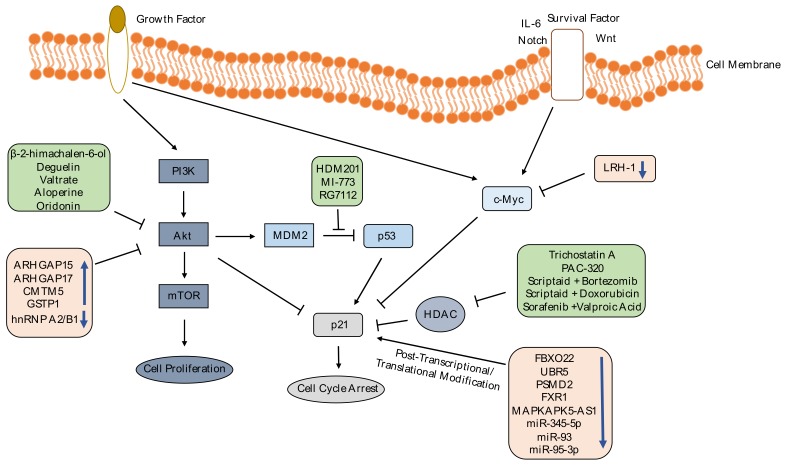Figure 1.
p21 expression induction through PI3K-Akt and c-Myc pathways. In this figure, drugs are shown in green boxes and differentially expressed genes/miRNAs are shown in pink boxes. These differentially expressed genes/miRNAs and drugs positively regulate p21 expression through reducing Akt phosphorylation, inhibiting MDM2-p53 interaction, suppressing c-Myc expression, preventing p21 ubiquitylation, preventing p21 mRNA destabilization, blocking negative regulation of p21 protein, or suppressing histone deacetylation. As a conclusion, increased p21 expression induces cell cycle arrest and decreases cell viability. PI3K: Phosphoinositide 3-Kinase, Akt: Protein kinase B, ARHGAP15: Rho GTPase-Activating Protein 15, ARHGAP17: Rho GTPase Activating Protein 17, c-MYC: cellular Myelocytomatosis Oncogene, CMTM5: CKLF (Chemokine Like Factor) Like MARVEL Transmembrane Domain Containing 5, FBXO22: F-box Only Protein 22, FXR1: Fragile X-related Protein 1, GSTP1: Glutathione S-Transferase Pi 1, HDAC: Histone Deacetylase, hnRNP A2/B1: Heterogeneous Nuclear Ribonucleoprotein A2/B1, IL-6: Interleukin 6, LRH-1: Nuclear Receptor Liver Receptor Homolog-1, MAPKAPK5-AS1: MAPKAPK5 Antisense RNA 1, MDM2: Mouse Double Minute 2, mTOR: Mammalian Target of Rapamycin, PI3K: Phosphoinositide-3-Kinase, PSMD2: 26S Proteasome non-ATPase Regulatory Subunit 2, UBR5: Ubiquitin Protein Ligase E3 Component N-Recognin 5.

